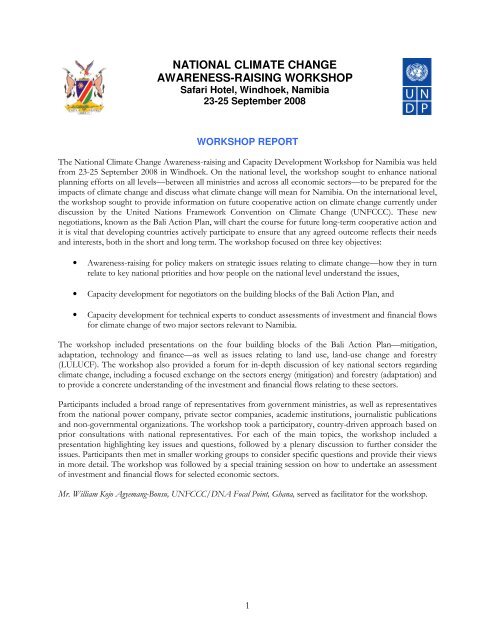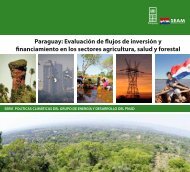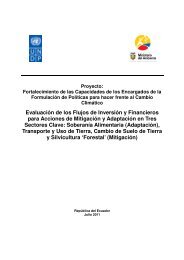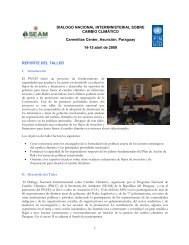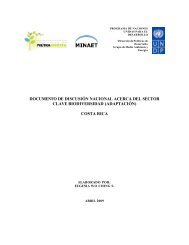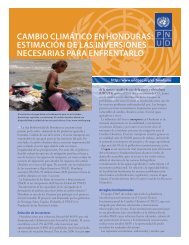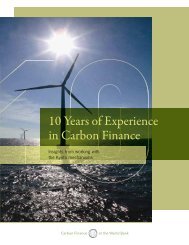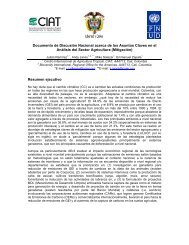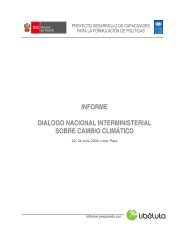national climate change awareness-raising workshop - UNDPCC.org
national climate change awareness-raising workshop - UNDPCC.org
national climate change awareness-raising workshop - UNDPCC.org
You also want an ePaper? Increase the reach of your titles
YUMPU automatically turns print PDFs into web optimized ePapers that Google loves.
NATIONAL CLIMATE CHANGE<br />
AWARENESS-RAISING WORKSHOP<br />
Safari Hotel, Windhoek, Namibia<br />
23-25 September 2008<br />
WORKSHOP REPORT<br />
The National Climate Change Awareness-<strong>raising</strong> and Capacity Development Workshop for Namibia was held<br />
from 23-25 September 2008 in Windhoek. On the <strong>national</strong> level, the <strong>workshop</strong> sought to enhance <strong>national</strong><br />
planning efforts on all levels—between all ministries and across all economic sectors—to be prepared for the<br />
impacts of <strong>climate</strong> <strong>change</strong> and discuss what <strong>climate</strong> <strong>change</strong> will mean for Namibia. On the inter<strong>national</strong> level,<br />
the <strong>workshop</strong> sought to provide information on future cooperative action on <strong>climate</strong> <strong>change</strong> currently under<br />
discussion by the United Nations Framework Convention on Climate Change (UNFCCC). These new<br />
negotiations, known as the Bali Action Plan, will chart the course for future long-term cooperative action and<br />
it is vital that developing countries actively participate to ensure that any agreed outcome reflects their needs<br />
and interests, both in the short and long term. The <strong>workshop</strong> focused on three key objectives:<br />
• Awareness-<strong>raising</strong> for policy makers on strategic issues relating to <strong>climate</strong> <strong>change</strong>—how they in turn<br />
relate to key <strong>national</strong> priorities and how people on the <strong>national</strong> level understand the issues,<br />
• Capacity development for negotiators on the building blocks of the Bali Action Plan, and<br />
• Capacity development for technical experts to conduct assessments of investment and financial flows<br />
for <strong>climate</strong> <strong>change</strong> of two major sectors relevant to Namibia.<br />
The <strong>workshop</strong> included presentations on the four building blocks of the Bali Action Plan—mitigation,<br />
adaptation, technology and finance—as well as issues relating to land use, land-use <strong>change</strong> and forestry<br />
(LULUCF). The <strong>workshop</strong> also provided a forum for in-depth discussion of key <strong>national</strong> sectors regarding<br />
<strong>climate</strong> <strong>change</strong>, including a focused ex<strong>change</strong> on the sectors energy (mitigation) and forestry (adaptation) and<br />
to provide a concrete understanding of the investment and financial flows relating to these sectors.<br />
Participants included a broad range of representatives from government ministries, as well as representatives<br />
from the <strong>national</strong> power company, private sector companies, academic institutions, journalistic publications<br />
and non-governmental <strong>org</strong>anizations. The <strong>workshop</strong> took a participatory, country-driven approach based on<br />
prior consultations with <strong>national</strong> representatives. For each of the main topics, the <strong>workshop</strong> included a<br />
presentation highlighting key issues and questions, followed by a plenary discussion to further consider the<br />
issues. Participants then met in smaller working groups to consider specific questions and provide their views<br />
in more detail. The <strong>workshop</strong> was followed by a special training session on how to undertake an assessment<br />
of investment and financial flows for selected economic sectors.<br />
Mr. William Kojo Agyemang-Bonsu, UNFCCC/DNA Focal Point, Ghana, served as facilitator for the <strong>workshop</strong>.<br />
1
Overview of the Bali Roadmap<br />
Presentation by Maria Netto, UNDP<br />
At the United Nations Climate Change Conference in Bali in December 2007, governments agreed to step up<br />
their efforts to combat <strong>climate</strong> <strong>change</strong> and adopted the “Bali Road Map”, which consists of a number of<br />
forward-looking decisions that are essential to reaching a secure <strong>climate</strong> future. The Bali Road Map takes a<br />
“two-track” approach. One track includes the Bali Action Plan, which charts the course for a new negotiating<br />
process under the United Nations Framework Convention on Climate Change (UNFCCC or “the<br />
Convention”), with the aim of completing this by 2009. It focuses on four “building blocks”: adaptation,<br />
mitigation, technology transfer and deployment, financing. The second track includes the current negotiations<br />
under the Kyoto Protocol, and their 2009 deadline, which focus on further quantified emission reduction<br />
commitments for industrialized countries (except for the U.S., which did not ratify the Protocol and currently<br />
has no legally binding target). The future relationship between these two tracks (i.e., will they remain separate<br />
or will the discussions be brought together) is another question being considered in the negotiations.<br />
Mitigation<br />
Presentation by Massamba Thioye, consultant for UNDP, Senegal<br />
Mitigation—the reduction of greenhouse gas emissions or enhancement of carbon “sinks”—is the most<br />
controversial issue under the Bali Action Plan. Human activity is contributing to <strong>climate</strong> <strong>change</strong> and all<br />
countries must reduce emissions to avoid the worst predicted damages: developed countries by 0 to -25%<br />
(smaller) to -25 to -40% (larger) in 2020 and developing countries "substantially" from baseline. Significant<br />
technological progress has been made, but annual investments of $200-210 billion are needed by 2030. In<br />
addition, forests and land use will be a big part of the solution. The Bali Action Plan calls on developing<br />
countries to identify mitigation actions that are: “measurable, reportable and verifiable” (MRV). The<br />
discussion on mitigation can be particularly difficult, since its outcome differs depending on which<br />
greenhouse gases are to be reduced, from which sources, by when and by how much (<strong>national</strong> vs. per capita<br />
emissions). A number of proposals are currently on the table, such as the “evolution of Clean Development<br />
Mechanism” (i.e. move to a sectoral approach) to “sustainable development policies & measures” (SD-<br />
PAMs). Developing country ministers will need to carefully consider which option(s) they can support.<br />
Plenary discussion on mitigation<br />
In the plenary discussion, participants noted that Namibia had different priorities than the larger developing<br />
countries and would therefore need a better understanding of the positions of countries with circumstances<br />
similar its own. Participants also raised questions on the types of compliance systems that would accompany<br />
the proposed mitigation options for developing countries, noting that these systems are often complex and<br />
burdensome. On mitigation action for Namibia, a number of participants highlighted the need for structural<br />
reform. For example, the selling of electricity includes a mark-up to cover other costs, such as salaries and<br />
local community cost. Therefore, there is resistance to reducing usage. Others highlighted the need for a<br />
<strong>national</strong> body to discuss the problem and develop an integrated <strong>national</strong> approach.<br />
Working Group discussions on mitigation<br />
What <strong>national</strong>ly appropriate mitigation actions, in the context of sustainable development, would have most support in Namibia<br />
Participants suggested a number of possible actions, including:<br />
• Promoting energy efficiency in all sectors of energy production. This requires assessing the entire<br />
chain of energy production. Structural reform and financial incentives for <strong>change</strong> are also needed.<br />
2
Reforms may be needed to allow for power inputs from independent suppliers. Demand side<br />
management and energy efficiency can only be achieved when appropriate regulations are in place;<br />
• Promoting renewable energy sources, including through tax incentives to lower to costs. Renewables<br />
such as wind, small hydro and geothermal could hold great potential for Namibia, as well as making<br />
it less dependent on imports from neighbouring countries;<br />
• Setting <strong>national</strong> standards in specific sectors, especially the transport sector with emission standard;<br />
• Setting <strong>national</strong> energy targets;<br />
• Fuel switching in the energy sector, such as to clean coal and/or natural gas, as well as fuel switching<br />
in the transport sector;<br />
• Possible <strong>change</strong>s in the land-use sector;<br />
• Improved building regulations;<br />
• Energy recovery and other mining improvements.<br />
There are also sector-specific actions for mitigation, such as improving pumping systems in the water sector,<br />
and promoting different species of plants in the agriculture sector. Other possibilities include:<br />
• Rural electrification: Introduction of appropriate technologies, including solar cookers.<br />
• Appropriate farming systems: In Namibia, farming is mostly done on woodlands in far northeast. It<br />
would be better to have more intensive farming, than to move onto marginal (less productive) lands.<br />
• Sustainable forest management through communities. For example, bee keeping could be a livelihood<br />
component of sustainable forest management.<br />
Some mitigation options are linked to adaptation, such as improvements to mining, which is highly “water<br />
sensitive”. Participants also stressed that public <strong>awareness</strong> is most important at this time–so that people<br />
understand why they should take action. This needs to be top down (policy makers) as well as bottom up<br />
(consumers), e.g. wood harvesting–cut down dead trees, not live trees (which are sinks).<br />
Is it realistic to expect that sufficient mitigation technologies will be developed and diffused, especially in the energy sector, even if<br />
there is no carbon cap<br />
Participants were divided on the issue. Some agreed that a <strong>national</strong> goal of some kind was needed or<br />
“business as usual” would simply continue. Others, however, said this was not needed, as some mitigation<br />
actions are already underway, such as with solar power. ESCOM in South Africa is replacing more efficient<br />
machines under demand-side management, which has already has ramifications in Namibia in the mining<br />
sector, where they are updating machines to be more efficient.<br />
Which measures do you consider as most appropriate or desirable for Namibia: Kyoto-style fixed targets, per capita entitlements,<br />
the Brazilian Proposal, SD-PAMs, CDM, etc<br />
Under the inter<strong>national</strong> sectors, some participants supported the “sustainable development policies and<br />
measures” (SD PAMs) approach, but noted that implementation would give rise to questions of how they<br />
could be “measurable, reportable and verifiable” as required under the Bali Action Plan. Any SD PAMs<br />
3
should be based on <strong>national</strong>, rather than regional, standards. Other participants supported the “enhanced<br />
CDM” approach, noting that some CDM activity was currently underway. Participants also emphasized that<br />
CDM approach would require enhanced support and/or technical backstopping, as there is no designated<br />
<strong>national</strong> authority (DNA) in Namibia. Enhanced CDM activities should start with industry, which has<br />
capacity to implement CDM projects. All participants agreed that Kyoto-style fixed targets would be<br />
inappropriate and, in any case, monitoring and compliance would be too difficult.<br />
Adaptation<br />
Presentation by Maria Netto, UNDP<br />
Adaptation—the process of sustainable and permanent adjustment to changing circumstances of <strong>climate</strong><br />
impacts—is the most important “building block” for Namibia. It is closely linked to development (the more<br />
developed a country is, the more adaptation options available) and needs to converge with disaster risk<br />
reduction activities. Discussion on adaptation has evolved in recent years and is increasingly focused on longterm<br />
preparedness. While impact assessments are dominated by uncertainties, it is clear that adaptation will<br />
require substantial funding (ten of billions of dollars). Much of the costs will be borne by government, which<br />
creates a challenge for developing countries with limited funds and few outside investments. Additional<br />
financial flows for adaptation will clearly be needed. Adaptation will require adjustments across every aspect<br />
of society, environment and economy. This in turn will require capacity for short- and long-term planning<br />
and adequate institutional arrangements (systematic planning, co-operation, and regulatory frameworks).<br />
Under the Bali Action Plan, four discussion topics have been identified: <strong>national</strong> planning for adaptation;<br />
streamlining and scaling up financial and technological support; enhanced knowledge sharing (there a lot of<br />
traditional knowledge, but its not well known); and institutional frameworks for adaptation.<br />
Plenary discussion on adaptation<br />
The plenary discussion focused on a range of topics relating to adaptation, which highlighted that Namibia<br />
already deals with a highly variable <strong>climate</strong>. Many speakers stressed the importance of agriculture, particularly<br />
referring to crop production, since 70% of the population depends on it for a livelihood, mostly for<br />
sustenance. Production for a market economy is problematic. The water sector, as far as rainfall <strong>change</strong>s or is<br />
delayed, is also vulnerable. In terms of water demand management, there are examples in Namibia of water<br />
banking, rain harvesting and subsidizing water for poorer parts of the country. The discussion also focused<br />
on institutional arrangements, and the lack of a coordinating body with regard to <strong>climate</strong> <strong>change</strong>.<br />
Adaptation Working Group Discussions<br />
For what key development priorities in Namibia would adaptation be necessary What are the first steps to integrate adaptation<br />
into such development priorities<br />
Participants highlighted many key development priority areas for Namibia, including agriculture, water, health,<br />
fishing, wildlife conservation, agro-tourism and mining. Namibia strives to be an industrialized country by<br />
2030, but adaptation measures to address <strong>climate</strong> <strong>change</strong> are needed in order to achieve this goal.<br />
Agriculture is relied on by 70% of the population. This sector should also be considered in context of agrotourism/conservation<br />
management. Proposed measures and policies included:<br />
• Broad-based strategies to help people <strong>change</strong> to livelihoods that benefit all communities and<br />
households. Provision of subsidies may be needed to implement some <strong>change</strong>s;<br />
• Agricultural diversification to include more species and crops adapted to Namibian conditions;<br />
4
o Awareness of increasing rate of foot-and-mouth, other diseases, effects of increased heat;<br />
o Genetically modified crops, e.g. s<strong>org</strong>hum, to increase overall crop resilience;<br />
o Land use planning–appropriate livelihoods for each area, e.g. not urban communities or<br />
livestock in marginal lands;<br />
<br />
<br />
<br />
Integrated <strong>national</strong> rangeland policy, in particular rangeland restoration, is needed;<br />
Wildlife relocation and biodiversity preservation (much of the basis of tourism)<br />
could require creating corridors for migration and enlarging protected areas. This<br />
would need to be incorporated into planning for parks and game preserves;<br />
Livestock breeds that can cope with limited grazing, beyond indigenous breeds, are<br />
needed. However, it is difficult to convince local farmers to do this.<br />
Urban development and land-use planning, which is primarily affected during floods and droughts, needs<br />
to consider adaptation and <strong>climate</strong> <strong>change</strong> impacts. In terms of impacts on present infrastructure, most<br />
buildings and other infrastructure are unprepared for extreme weather events. Proposed measures include:<br />
• Improved training for civil engineers/urban planners;<br />
• Increased funding for improved development;<br />
• Ensure that <strong>climate</strong> <strong>change</strong> risk assessments and/or environmental impact assessments are<br />
conducted before any infrastructure projects are carried out. This includes thorough consideration of<br />
planning and zoning issues with regard to where infrastructures are built.<br />
Health measures to combat the risk of widespread cholera and malaria are also adaptation measures, as<br />
changing <strong>climate</strong>s such as flooding create the conditions for spreading these diseases. Improved composting<br />
techniques can also lower health risks. Dryness can also bring diseases, like through heat waves. Droughts can<br />
also affect nutrition.<br />
Tourism could also be subject to adaptation measures. A move towards a mix of animal husbandry with<br />
wildlife management could increase of tourism by making Namibia an environmental showcase.<br />
Mining is largest contributor to the <strong>national</strong> economy. Scarcity of water and energy can have major effects<br />
on this sector. Proposed measures therefore should focus on more cost-efficient, long term water<br />
management strategies, such as water harvesting, recycling and improved water conservation.<br />
Research and development should be improved to develop further adaptation techniques applicable to<br />
Namibia. These should also tap into indigenous knowledge at local level.<br />
What mechanisms should be put in place, <strong>national</strong>ly and inter<strong>national</strong>ly, to provide effective means for adaptation to <strong>climate</strong><br />
<strong>change</strong>, including financing What policy <strong>change</strong>s should be made to cope with the current and expected impacts of <strong>climate</strong> <strong>change</strong><br />
• Climate proofing the <strong>national</strong> development goals (Vision 2030) will be needed to ensure their<br />
achievement. This means implementing a range of policies, which need to be harmonised –<br />
sometimes policies conflict or undermine each other, e.g. settlement vs. conservation.<br />
5
• Country Pilot Partnership Programme (CPPP), which currently tries to make land use planning<br />
harmonised and integrated, could be maximized. It involves six ministries, including mining,<br />
agriculture, and tourism.<br />
• Settlement planning could prevent incidents such as the losses resulting from recent flooding, which<br />
were made worse by poor planning. As a result, insurance is no longer available for that area. Microinsurance<br />
schemes could also be used to deal with the results of hazards.<br />
• Financing is a key issue, particularly for local communities. Inter<strong>national</strong> and <strong>national</strong> funding are<br />
needed.<br />
Inter<strong>national</strong><br />
• Developed countries should provide adaptation costs to developing countries. This is fundamental to<br />
any proposal. Funding is needed for the improvement of early warning systems, which are linked to<br />
disaster risk reduction. Funding is also needed for capacity building. Several institutions are currently<br />
designing a capacity building strategy on <strong>climate</strong> <strong>change</strong> issues.<br />
• Well-informed negotiators are needed in the inter<strong>national</strong> process to ensure that Namibia’s needs are<br />
reflected in the outcomes.<br />
• Further work is needed on the costing for adaptation in order to convince policymakers and others<br />
that <strong>climate</strong> <strong>change</strong> is here to stay. Namibia already has a centre for excellence that could help.<br />
National<br />
• Better cooperation with the Meteorological Services to inform farmers in a timely manner. SADC as<br />
a region is working with farmers on impacts and possible planning.<br />
• Improvements to water farming and storage, rather than relying on dams, would help. Large-scale<br />
investment in water pumping for water storage in ground water levels and additional external grants<br />
for smaller water towers would be needed.<br />
• Taxation policies as a tool to promote adaptation should be considered.<br />
• Campaigns to raise <strong>awareness</strong> of inaction on <strong>climate</strong> <strong>change</strong> could also support <strong>national</strong> action.<br />
What further analysis would be needed to support Namibia in preparing to adapt to <strong>climate</strong> <strong>change</strong> What are future actions<br />
and key considerations at the <strong>national</strong> level for adaptation<br />
• Modelling—Namibia needs a better understanding of its overall rainfall patterns (also at sub regional<br />
level). Not only for the distribution of rain in different regions, but over time as well.<br />
• Insufficient data for robust analyses of overall trends resulting from <strong>climate</strong> <strong>change</strong>. Sometimes<br />
information is available, but not accessible.<br />
• More in depth understanding of <strong>climate</strong> variability and vulnerability mapping, i.e. making database of<br />
which areas are most vulnerable. This would include better use of GIS systems and promoting<br />
participatory approaches.<br />
6
• More <strong>national</strong> studies, e.g. <strong>national</strong> communications. Private sector also does modelling – in mining,<br />
which may have looked at <strong>climate</strong> <strong>change</strong> impacts<br />
• Strengthen institutional coordination. This would bring in policy makers to support stakeholders.<br />
• Capitalise on <strong>national</strong> competitive advantages and add value, e.g. fisheries, beef, create markets for<br />
game meat<br />
For all adaptation measures, participants stressed the need for improved <strong>awareness</strong> <strong>raising</strong> efforts. Climate<br />
<strong>change</strong> messages must relate to people in terms that are relevant to them and increased extension efforts are<br />
needed to reach people.<br />
Some efforts to reduce poverty are also linked to adaptation. For example, efforts to spread the risk of<br />
income loss by diversifying livelihoods options into sustenance crops, market crops and other sectors can<br />
lower vulnerability risks to <strong>climate</strong> <strong>change</strong> and decrease poverty.<br />
Technology<br />
Presentation by Mr. William Kojo Agyemang-Bonsu, UNFCCC/DNA Focal Point, Ghana<br />
Combating <strong>climate</strong> <strong>change</strong> will require improvements in all aspects of technology transfer—research,<br />
development, deployment, demonstration and diffusion. While investments in clean energy are growing fast,<br />
including new financial products and markets, there is a substantial financing gap for the required scaling up<br />
needed to address <strong>climate</strong> <strong>change</strong>. The most favoured technologies in recent years including: wind, solar,<br />
biofuels (renewables increasingly relevant), cleaner fossil fuels generation and (especially for Africa) energy<br />
efficient building and appliances. Carbon markets (including the CDM) can play important role for<br />
developing countries, although smaller and lower-income countries have yet to see benefits. Technology is a<br />
key modality for mitigation and adaptation, and is gaining momentum in the inter<strong>national</strong> negotiations.<br />
Developed countries are obligated to support transfer of technologies to developing countries under the<br />
Convention. The extent to which they can undertake both mitigation and adaptation will depend on this.<br />
Important aspects of the current discussion include the dissemination of technology information and<br />
networking, as well as strengthened research and capacity building. Key barriers can be financing, intellectual<br />
property rights and tariffs. A key future concern would be to consider not only developed country action, but<br />
also improvement to cooperative action so that countries can work together.<br />
Plenary discussion on technology<br />
Participants discussed possible problems with the sectoral approach to developing mitigation targets,<br />
particularly with regard to market restrictions. Some viewed this as a means of hindering development that<br />
could turn into a trade barrier, as it implies an inter<strong>national</strong> standard and their companies may not be able to<br />
compete in the market. Speakers stressed that technology transfer will require more training. Some thought a<br />
training component should be obligatory with any transfers. The discussion also focused on Namibia’s<br />
technology needs assessment (TNA), completed in 2005. The TNA identified priority technologies, including<br />
water and energy efficiency, as well as solar water heaters. Key barriers included insufficient <strong>awareness</strong>,<br />
social/cultural barriers and financial barriers. There was also a lack of institutional <strong>awareness</strong> on the CDM.<br />
7
Technology Working Group Discussions<br />
What role could the Namibian government play in the development, deployment and transfer of technologies<br />
Government has several key roles to play with regard to technology, including:<br />
• Creating favourable policy and legislative conditions, such as setting <strong>national</strong> goals and realistic<br />
development targets. This can also include provision of funding and/or tax incentives, as well as<br />
removing tariffs. In addition, this includes improved protection of intellectual property rights (IPRs)<br />
and adjustments to limited foreign ex<strong>change</strong> rules (which limits the willingness of foreign investors);<br />
• Selecting and promoting key technologies, as well as identifying those capable of deploying<br />
technologies; Providing investment vehicles to start businesses that use inter<strong>national</strong> technologies;<br />
• Assisting with access to inter<strong>national</strong> resources, possibly by having a <strong>national</strong> focal point for<br />
technology; facilitate access to external experts (make it easier for them to come in and train);<br />
• Take steps to prevent “brain drains” of technologically trained people. (This also pertains to the<br />
private sector, which provides incentives to retain highly trained personnel).<br />
• Supplying the training for local workforce on new technologies. Improvements are needed for<br />
vocational training centres, to the extent they are involved. Also, universities need to build<br />
programmes geared toward technology with clear research mandate and appropriate resources.<br />
• Undertake pilot projects and demonstration projects, including CDM projects, that bring in new<br />
technologies;<br />
• Facilitating public <strong>awareness</strong>.<br />
A number of challenges were also identified, such as:<br />
• Government does not really undertake research, which implies they may not be the best decision<br />
makers on technology.<br />
• Conflicts between government and private sector approaches, e.g. government is interested in<br />
nuclear power, but nuclear is not part of the <strong>national</strong> power company’s short term planning.<br />
Are there specific roles for the private sector in the development, deployment and transfer of technologies, and would the private<br />
sector on its own be motivated to fulfil these expected roles<br />
• Development of “hard” technologies will largely be driven by private sector. In Namibia, mining can<br />
play a key role in technology development, but still technologies are often external.<br />
• Private sector can be motivated to act on its own if solutions are cost-effective. The <strong>national</strong> power<br />
company is also <strong>raising</strong> <strong>awareness</strong> on demand side (not just supply side).<br />
How can Parties accelerate the progress in all stages of the technology process from technology innovation to application<br />
• Main barriers are financial: but who will pay There is a need for an inter<strong>national</strong> coordinating body<br />
with funding to be established to encourage technology transfer.<br />
8
• In parallel, there is also a need for a leading agency at the <strong>national</strong> level that is driving technology<br />
development that is <strong>national</strong>ly appropriate, e.g. Ministry of Trade & Industry.<br />
What are the opportunities for ex<strong>change</strong> of experience at the regional level; what would be the role of regional centres of excellence,<br />
as recently proposed by the G-77/China.<br />
• There is some concern that a single centre of excellence, e.g., in South Africa, would be dominated<br />
by the concerns of the host country.<br />
• Many countries are too small to fund research on their own and inter-disciplinary ex<strong>change</strong> of<br />
expertise is needed. The centres can play a key role in technology dissemination.<br />
Finance<br />
Presentation by Maria Netto, UNDP<br />
Considerable amounts of additional investment and financial (I&F) flows will be needed to assist developing<br />
countries in addressing <strong>climate</strong> <strong>change</strong>. Mitigation measures will require additional I&F flows of $200-210<br />
billion in 2030. Adaptation measures will require additional I&F flows in 2030 of several tens of billion of US<br />
dollars. While these amounts are amounts are large in absolute terms, they are small relative to global GDP<br />
and investment. Both the Convention and Kyoto Protocol foresee financial assistance for developing<br />
countries, and address the issue in many of their provisions. Current financial assistance can come through<br />
the “Financial Mechanism” (i.e., GEF) or bilateral, regional or other multilateral channels. Parties have also<br />
established two new GEF funds: the Least Developed Countries Fund and the Special Climate Change Fund.<br />
An Adaptation Fund has also been established under the Kyoto Protocol. Key issues currently being<br />
discussed under the Bali Action Plan include: improved access to adequate, predictable and sustainable<br />
financial resources; new and additional funding; positive incentives to implement mitigation and adaptation<br />
actions; innovative funding means to meet adaptation costs; and, mobilisation of public and private sector<br />
funding. At the most recent talks in Accra in June 2008, the G-77/China proposed a completely new fund<br />
under the COP.<br />
Plenary discussion on finance<br />
Participants highlighted the difficulties in calculating the additional financial flows needed beyond “business<br />
as usual” investments annually. Even more difficulties arise with regards to costing. As important as getting<br />
new money is showing accountability. The criteria for expenditures and disbursements will be difficult to<br />
agree. It was also noted that many <strong>national</strong> communications so far were not looking at long-term preparations,<br />
so considerable work is needed to demonstrate that they need these funds. Capacity building is an important<br />
part of this. Some participants stressed accessibility as the key issue—while more funds may be established,<br />
this may only make the process more complex. It was noted that few countries from Africa actually benefit<br />
from the existing windows.<br />
Working Group Discussions on Finance<br />
What could be the main mitigation options in Namibia What could be the main adaptation options in Namibia What<br />
<strong>change</strong>s to the investment and financial flows would implementing these options entail<br />
• For mitigation, the main options involve the energy sector. This includes electricity production and<br />
transport, which hold the greatest potential for tapping into inter<strong>national</strong> funding. Mining will also<br />
play a key role in mitigation, but is largely private sector and profit driven.<br />
• For adaptation, the main options involve agriculture, land use and health.<br />
9
National options<br />
• Government could establish a fund for the impacts of <strong>climate</strong> <strong>change</strong>. Other examples exist, such as<br />
the Namibian fund for wildlife conservation. A <strong>national</strong> resource for funding would be needed to<br />
offset uncertainty of inter<strong>national</strong> funding. Ensuring that companies or major polluters make<br />
voluntary contribution to the fund in order to get a tax break could help. The money saved from<br />
other <strong>change</strong>s to the system could be used to establish a revolving fund to pay for further efforts.<br />
• Ministry of Finance could create incentives for people/institutions undertaking adaptation and<br />
mitigation activities.<br />
• The <strong>national</strong> water company could be obligated to encourage water-conservation activities and<br />
provide incentives to users.<br />
• Increased capacity is needed for the Ministry of Finance and other planning institutions to increase<br />
the country’s chances of benefiting from investment in-flows.<br />
• There is also need to base investments on partnerships, rather than be investor driven. Currently,<br />
investors choose, then proceed. Instead, investment options need to be identified by the country.<br />
• Mainstreaming of <strong>climate</strong> <strong>change</strong> with the government is required–the National Climate Change<br />
Committee (NCCC) could play a stronger role in harmonising funding requests and sharing<br />
information with all stakeholders. A full-time focal point or secretariat is needed.<br />
• Within the <strong>national</strong> planning mechanism, any areas where <strong>climate</strong> <strong>change</strong> is identified as a major<br />
threat, the requirements must be factored into <strong>national</strong> budgets.<br />
• For all measures, there is a need to have the real costs of <strong>climate</strong> <strong>change</strong> adaptation and mitigation,<br />
so that inter-sectoral discussions can take place.<br />
Inter<strong>national</strong> options<br />
• Difficulties in accessing funds are a major problem. The African Development Bank has millions for<br />
<strong>climate</strong>, but only 5% accessed annually. Awareness <strong>raising</strong> is needed on funding opportunities.<br />
Namibian National Context<br />
Presentation by Uazamo Kaura, Ministry of Environment and Tourism, Namibia<br />
Key sectors for Namibia that face impacts from <strong>climate</strong> <strong>change</strong> include agriculture, fisheries, water, livestock<br />
and health. Agriculture, which accounts for 6.5% of GDP, faces decreases in yield and a greater inter-annual<br />
variability. Livestock farming, which accounts for 8.2% of GDP, faces drought-reduced production and<br />
reproductive potential, as well as increased incidence of pests and livestock disease. For fisheries, which<br />
account for 5.3% GDP, there are multiple risks to fishery dependent communities, including export revenues<br />
losses and employment losses. These and other issues were addressed in Namibia’s second <strong>national</strong><br />
communication, which resulted a number of outputs, including an energy review, an updated greenhouse gas<br />
inventory review, a vulnerability assessment, identification of research needs for farming systems,<br />
identification of <strong>national</strong> circumstances and identification of infrastructural support to reduce vulnerability.<br />
Some of the key recommendations from the second <strong>national</strong> communication included fuel switching for<br />
energy, water harvesting techniques for agriculture, disaster risk preparedness and <strong>awareness</strong> <strong>raising</strong> on<br />
<strong>climate</strong> <strong>change</strong>.<br />
10
Namibian National Report on Land Use, Land Use Change and Forestry (LULUCF)–Adaptation<br />
Presentation by Dr. Juliane Zeidler, Integrated Environmental Consultants Namibia (IECN)<br />
Activities in the land use sector will play a central role in Namibia’s adaptation to <strong>climate</strong> <strong>change</strong>. The term<br />
“LULUCF” comes from the UNFCCC and the Kyoto Protocol and includes six broad categories. Namibia,<br />
on the other hand, approaches the issue of land use in a more integrated manner that addresses all key<br />
production systems: (1) agriculture, including crops and livestock, (2) forestry, (3) fisheries (inland), (4)<br />
tourism, (5) wildlife and (6) the underlying ecosystem services. Degradation issues are critical, as the expected<br />
impacts of <strong>climate</strong> <strong>change</strong> will exacerbate already pressing environmental problems. Namibia is the most arid<br />
country in sub-Saharan Africa and already deals with climatic extremes. Some autonomous adaptation<br />
measures, such as conversion from livestock to wildlife-based farming, are already occurring. Some of the<br />
required measures for strengthening adaptation include: ensuring access to high-quality information about the<br />
impacts of <strong>climate</strong> <strong>change</strong> and carrying out vulnerability assessments; increasing the resilience of livelihoods<br />
and infrastructure using existing knowledge and coping strategies; and improving governance, including a<br />
transparent and accountable policy and decision-making process and an active civil society. Conducting an<br />
assessment of investment and financial flows for adaptation will require some key information, including:<br />
reliable information on expected impacts; the costs and benefits of action vs. inaction to make a good<br />
business case; key adaptation options to be strategized and costed; identification of opportunity cost of<br />
upgrading and <strong>climate</strong>-proofing existing investments, policies and project interventions; and information on<br />
current investments and financial in order to form a baseline.<br />
Working Group Discussion on Land Use–Adaptation<br />
What are future actions and key considerations at the <strong>national</strong> level for adaptation in the land-use sector (in terms of prioritising<br />
sectors/planning/policy development/opportunities)<br />
• Land-use zoning and integrated ecosystem management planning is critical: government is currently<br />
developing a land-use zoning strategy–but is there sufficient coordination between Ministries<br />
Government should make land available for resettlement for those currently living on marginal lands.<br />
• Promotion of indigenous land-use systems and diversification of farming are needed. In Namibia,<br />
only 10% of land is suited to intensive agriculture and many crops grown are not indigenous. Are the<br />
crops grown here are the best option for Namibia, while also addressing the issue of markets Are<br />
the crops are cost-effective in context of water<br />
• New management schemes are needed for livestock management. Owners do not <strong>change</strong> when the<br />
<strong>climate</strong> does. They still keep really large farms and herds even when the weather <strong>change</strong>s.<br />
• Reforestation with indigenous species.<br />
• Agro-tourism. Government policies that support this approach and provide ownership are needed.<br />
What are the major barriers in Namibia for implementing land use adaptation options<br />
• Capacity<br />
• Land tenure issues. People need ownership rather than communal land to create a motivational effect<br />
and the benefits of adaptation. They can also diversify rather than focusing on livestock, or remove<br />
fences to encourage migration.<br />
11
• Value of land-in communal sector<br />
• Cultural norms present a barrier. Some people stick to what they know even when it does not work.<br />
• Lack of appropriate technologies and funding to acquire them.<br />
• Lack of access to insurance options<br />
• Lack of political will – the Permanent Secretary is a critical stakeholder, but he or she may have<br />
personal agendas and may <strong>change</strong> (hence the need for continual <strong>awareness</strong>-<strong>raising</strong>).<br />
• Political consistency/institutional memory<br />
• Ministerial co-ordination and policy harmonisation<br />
• Lack of development loans to encourage <strong>change</strong>s in livelihoods such as agro-tourism<br />
Have incentive mechanisms have been used in Namibia in the land use sector<br />
• Communal area conservancy<br />
Namibian National Report on the Energy Sector– Mitigation<br />
Presentation by Dr. Detlof von Oertzen, Desert Research Foundation of Namibia<br />
Accessible and reliable energy is the key to economic growth and must be addressed when considering efforts<br />
to mitigate greenhouse gas emissions. Primary energy carriers for Namibia include liquid fuels, biomass,<br />
liquefied petroleum gas (LPG), hydro and renewables, which provide energy for manufacturing, power<br />
generation and electricity. There are a number of possible measures to lower emissions in the energy sector.<br />
In the transport sector, possible measures include enhancing the fuel efficiency of the <strong>national</strong> fleet; providing<br />
incentives for fuel switching to LPG and biofuels; and increasing the application of energy efficiency<br />
measures. In the electricity sector, measures could include improving energy efficiency and demand-side<br />
management; hydro-electric generation schemes; increased use of renewables such as biomass, wind, solar,<br />
geothermal and wave; increased use of natural gas; and possibly increased use of clean coal. There are a<br />
number of issues and concerns to be considered when assessing investment and financial flows for Namibia.<br />
Energy needs to be treated as a crosscutting economy-wide theme and should be reflected in Vision 2030 and<br />
other policy documents. There are also problems with feeding in energy into the overall network. In addition,<br />
little is done to provide incentives for foreign investments in the energy sector. Namibia needs to make the<br />
energy sector more productive, provide incentives to reward smart production and attract new investors.<br />
Working Group Discussion on the Energy Sector<br />
What tools do you consider as most appropriate or desirable for Namibia: taxes and charges, financial incentives, voluntary<br />
agreements, information instruments, tradable permits, research and development, etc<br />
• Carbon tax would be useful to encourage movement away from fossil fuels and towards more<br />
energy-efficient options;<br />
• Voluntary agreements;<br />
12
• Financial incentives: This would encourage a move towards energy efficiency by both consumers and<br />
industries. Incentives for a coordinated approach to energy projects under the CDM would help;<br />
• Information instruments are already being used in Namibia but could be strengthened;<br />
• Research and development is needed to understand available technology.<br />
What further analysis will be needed to support Namibia in taking <strong>national</strong>ly appropriate mitigation actions What are future<br />
actions and key considerations at the <strong>national</strong> level for<br />
• A comprehensive energy strategy and development strategy that can support Vision 2030 and<br />
encourage more energy efficiency;<br />
• Political will to create an enabling environment and financial incentives to invite energy efficient<br />
projects and investments, e.g. for a solar farm, biomass–especially since there is potentially a conflict<br />
of interest with the <strong>national</strong> power company (especially if no renewable energy targets);<br />
• The Ministry of Mines and Energy should consider a rural electrification strategy, which should<br />
include renewables or energy-efficient options;<br />
• Need improved information sharing between sectors and ministries, both of <strong>national</strong> information<br />
and external projects (e.g. GTZ project on biomass in other south/east African countries);<br />
• The Namibian White Paper on energy needs to be updated.<br />
• Floating nuclear was not supported.<br />
Concluding session<br />
Participants provided feedback on the <strong>workshop</strong> and discussed next steps at the <strong>national</strong> level. Many<br />
highlighted the usefulness of the <strong>workshop</strong> in bringing their attention to new issues, particularly aspects<br />
relating to the inter<strong>national</strong> process. They also stated that the <strong>workshop</strong> provided a tremendous opportunity<br />
by bringing together different ministries and other representatives to discuss the financial aspects of <strong>climate</strong><br />
<strong>change</strong> and the need to develop a long-term approach. In the future, <strong>workshop</strong>s such as this will need to<br />
reach out even further. For many, the discussions in the <strong>workshop</strong> also improved their understanding of<br />
<strong>national</strong> issues, particularly with regard to the barriers and bottlenecks. More work is needed on the<br />
understanding the resources needed and how best to position the country to receive funds. There are many<br />
steps to follow as the negotiations continue.<br />
Participants agreed that the <strong>workshop</strong> had highlighted a number of areas that needed further<br />
collaboration, and provided some indication of the policy options that are most relevant for<br />
undertaking an assessment of investment and financial flows (I&F). These policy options would need<br />
to be further analyzed in the context of the <strong>national</strong> communications.<br />
In closing, the facilitator highlighted some important steps for follow-up at the <strong>national</strong> level, including:<br />
• Establishing a set of <strong>national</strong> goals and objectives;<br />
• Engaging Namibia’s sophisticated private sector, which can help pilot new ideas and give Namibia<br />
comparable advantage over other countries;<br />
13
• Designating an office or group to provide leadership for adaptation and mitigation actions. Currently,<br />
consideration of <strong>climate</strong> <strong>change</strong> is very piecemeal. Consolidation of information will be a key goal;<br />
• Learning more about inter<strong>national</strong> benchmarking and where Namibia stands in comparison to other<br />
countries;<br />
• Devolving management to the local level.<br />
Another important action will be the convening of a stakeholder meeting to follow up on the specific<br />
topics raised during the <strong>workshop</strong> and the establishment of teams, selected on the basis of their<br />
specific expertise, to conduct the assessment of investment and financial flows.<br />
Day 3: Special session for <strong>national</strong> experts undertaking investment and financial flows assessment to<br />
address <strong>climate</strong> <strong>change</strong>.<br />
Introduction to the UNDP Approach for Assessing Investment and Financial Flows to address<br />
Climate Change<br />
Presentation by Bill Dougherty, Stockholm Environment Institute (USA)<br />
This presentation sought to provide a starting point for the analysis needed to assess investment and financial<br />
(I&F) flows to address <strong>climate</strong> <strong>change</strong>, including: an overview of key concepts; review the methodology;<br />
application of the methodology to energy sector; and, application of the methodology to the LULUCF sector.<br />
In discussing key concepts, it was emphasized that:<br />
• Investment flows include investments in new facilities or equipment, e.g. renewable energy sources,<br />
expanded water supply systems, capital cost of a gas-fired generating unit. This represents the initial<br />
(capital) cost of a new physical asset with a life of more than one year. The focus is on investment<br />
decisions and new physical assets, but not operating costs.<br />
• Financial flows include on-going expenditures e.g. forest management or illness treatment. This<br />
represents the ongoing cost related to mitigation or adaptation that does not involve physical assets.<br />
Financial flows sounds similar to investment flows, but it is different. It is the flow of expenditures<br />
incurred by <strong>national</strong> agencies to maintain the new investments for achieving mitigation and<br />
adaptation goals. The approach is most useful for assessments of sectors that do not involve<br />
investment in new facilities or equipment.<br />
It is important to note that, for any measure within a sector, the investment or financial flows are estimated—<br />
but not both. It was also noted that this type of assessment of I&F flows would be a new kind of analysis.<br />
While the UNFCCC secretariat in 2007 undertook an assessment of global financial flows, this assessment<br />
will be an opportunity to undertake an analysis on the <strong>national</strong> level.<br />
“User Guidelines” for undertaking an assessment of I&F flows are also being prepared. The goals of the User<br />
Guidelines are to:<br />
• Better understand future I&F flows that simultaneously address <strong>climate</strong> <strong>change</strong> and fit within the<br />
development priorities of a country for a specific sector;<br />
14
• Provide guidance on how to conduct the actual assessment of I&F flows, while also being a flexible<br />
process that <strong>national</strong> teams can use to better understand the investment and financial implications of<br />
<strong>national</strong> <strong>climate</strong> <strong>change</strong> mitigation and adaptation strategies.<br />
A presentation was also provided on the key elements of the methodology for assessing I&F flows (see full<br />
presentation attached). Participants then discussed the kind of data needed and where to find it, how to<br />
access and evaluate the data, how to set boundaries for the sector (i.e. only electricity or the entire energy<br />
sector), scenario development for the mitigation and adaptation scenarios, and ways to model the information.<br />
It was noted that technical backstopping would be provided for supporting the production of the analysis. An<br />
additional weeklong training may also be necessary. Key pre-requisites for the assessment will be: identifying<br />
the project team and assigning roles, clearly understanding the methodology, and defining the scope of each<br />
sector to be assessed.<br />
Mitigation scenario–Energy<br />
Participants discussed the five steps for the assessment—scoping out the effort, establishing the reference<br />
scenario, establishing the mitigation scenario, estimating incremental investment flows, and synthesizing<br />
results. In a sample mitigation scenario, a reasonable attempt to add <strong>climate</strong> measures might be to increase<br />
the percentage of energy received from solar or diesel (which is cleaner than coal). This would fulfil <strong>national</strong><br />
development aspects and address <strong>climate</strong> <strong>change</strong>. The resulting synthesis should include a summary that<br />
provides the highlights of the broader picture followed by a detailed technical report that spells out the<br />
assumptions and data used for arriving at numbers.<br />
In the discussion, participants noted that possible data sources could include:<br />
• National household income and expenditure surveys;<br />
• Energy sector reviews;<br />
• National resource accounts;<br />
• Studies under the Namibia Renewable Energy Programme.<br />
Possible institutions that may have useful data include:<br />
• Governmental bodies, such as the Ministry of Environment and Tourism, which has been involved<br />
with the <strong>national</strong> communication, the Ministry of Mines and Energy, the National Planning<br />
Commission and the Ministry of Finance and the Investment Centre and possibly the Ministry of<br />
Industry and Trade;<br />
• Polytechnic of Namibia (which already has a good CDM scenario);<br />
• Non-governmental <strong>org</strong>anizations, like the Desert Research Foundation;<br />
• The Electricity Control Board;<br />
• Nampower (<strong>national</strong> power company).<br />
A <strong>national</strong> team will be created and will get funding from UNDP to undertake the assessment. The UNDP<br />
office in New York will come up with drafts based on inputs received at this <strong>workshop</strong>, as well as the recent<br />
training at the “global” <strong>workshop</strong>. An ideal team could include individuals involved in planning, financial and<br />
investment matters, and policymakers familiar with the current <strong>climate</strong> dialogue. Consultations with all<br />
<strong>org</strong>anizations will be needed to create a work programme for the assessment. It is important to involve<br />
different institutions according to their capacity.<br />
Adaptation–Land use<br />
Adaptation is a more challenging issue and work on the adaptation scenario has only begun recently. The<br />
adaptation scenario will require the same five steps and basic framework as used for mitigation, but applied to<br />
a different set of circumstances. For example, Step 1 (scoping out the effort) will require establishing a time<br />
15
horizon for the assessment. In the past, adaptation was discussed only in the long term. However, adaptation<br />
is now also discussed in terms of short-term <strong>climate</strong> variability, since there are already perceptible <strong>climate</strong><br />
<strong>change</strong> impacts being felt by countries.<br />
In the discussion, participants raised a number of issues and questions, such as whether the adaptation<br />
scenario should cover managed forests or unmanaged forests, as well as whether it would include plantations<br />
and protected areas. Some participants noted that the focus should not be limited to forestry, but include the<br />
broader system of land use and rural livelihoods through better management. Some recalled that, unlike the<br />
mitigation scenario which focuses on measurable emission reductions, the adaptation scenario should focus<br />
on reducing the vulnerability of communities to <strong>climate</strong> <strong>change</strong>, which is a much more difficult concept.<br />
Participants also discussed possible resources for helping set boundaries for the assessment. While<br />
information is available in <strong>national</strong> accounts, it would need to be “teased out”. On forestry resources, the<br />
UNFCCC secretariat has produced a compendium of models to assess <strong>climate</strong> <strong>change</strong> vulnerability.<br />
After reviewing the last four steps, participants generally agreed that an indicative scenario could be created.<br />
Previous work on inventories could provide useful information. The country team would need to establish<br />
dynamic scenarios and produce an indicative funding gap for adaptation. Possible data sources include:<br />
• The Ministry of Environment and Tourism, which has well established forest accounts and<br />
enterprise-based models of investment portfolios;<br />
• A recent detailed analysis completed for the Millennium Challenge Corporation in the US included<br />
the “green scheme” on irrigated agriculture. This should have fairly good economic data on the<br />
irrigation sector and livestock sector;<br />
• An agriculture census completed a few years ago;<br />
• Participatory surveys that look at household data;<br />
• The Community Based Natural Resources Management Report;<br />
• Information on forest products, which could credibly be extrapolated to other areas;<br />
• Capacity building reports for Land Boards in the regions on land use planning;<br />
• Detailed surveys of standing stocks done by community forest programs;<br />
• A major study on bush encroachment (a carbon sink, but leads to loss of farming revenue);<br />
• University of Cape Town studies on vegetation.<br />
How does one construct a viable adaptation scenario for Namibia Possible policy options could include<br />
dealing with variability by diversifying farming system into perennials, which could involve using local water<br />
harvesting and storage. This in turn would require investments and financial flows, which could possibly be<br />
offset with carbon credits. There are also options that would make use of traditional knowledge for dealing<br />
with extreme <strong>climate</strong> variability. Other options could be drawn from the extensive inter<strong>national</strong> literature<br />
available on dry land management.<br />
Participants agreed that creativity would be needed for adaptation scenarios. All of the examples discussed<br />
relate to making livelihoods more resilient to the impacts of <strong>climate</strong> <strong>change</strong>. There is a richness and range of<br />
measures that could be introduced as part of this scenario. In addition, it will be important to work in “shock<br />
absorbers” to deal with setbacks. Most of the ideas are not covered the second <strong>national</strong> communication or<br />
integrated into ongoing adaptation work, as much of that work has been done on coastal areas and water<br />
issues. Namibia presents a challenge, given its natural diversity, which is why options are important. The<br />
country team will need to cost them out in sections of the assessment for delineating the scope.<br />
Closing<br />
UNDP noted that it would produce a report of the <strong>workshop</strong>, as well as terms of reference outlining the<br />
technical capacities needed to undertake the assessment of financial flows and the data needed. Namibia will<br />
16
now need to develop a work plan indicating the individuals to be hired and their responsibilities, as well as a<br />
timeline for producing the assessment prior to COP 15 in December 2009. In addition, regional centres of<br />
excellence, which will provide technical assistance, will need to be selected. Lastly, the importance of a solid<br />
country team was highlighted, as the underlying idea of the project is to have different ministries working<br />
together to ensure the accuracy of the assessment.<br />
A representative from Namibia agreed that the process would require considerable coordination from the<br />
<strong>org</strong>anizations that host the needed data. Team members will be assigned after a meeting of the National<br />
Climate Change Committee (NCCC). Some incentive measure may be needed for colleagues that are already<br />
overburdened. Lastly, she thanked UNDP for placing confidence in Namibia for this important pilot project.<br />
17
LIST OF PARTICIPANTS<br />
Name Position Organisation Telephone no. Email address<br />
1. Jonas Capoco Managing Director ASCA Investments 061 272 203 asca@mweb.com.na<br />
2. J. Ndokosho Project Coordinator CCA MAWF 065 251 291 jndokosho@cppnam.net<br />
3. Kenneth Uiseb Project Manager Consulting Services Africa 081 223 1707 kennethu@csa-<strong>org</strong>.na<br />
4. Pierre du Plessis Consultant CRIAA SADCICEMA/NCCC 081 251 0672 Pierre@criaasadc.<strong>org</strong><br />
5. Detlof von Oertzen Executive Director DRFN 061 377 500 Detlof.von.Oertzen@drfn.<strong>org</strong>.na<br />
6. Erik Dirlcx Coordinator DRFN 061 377 520 Erik.dirlcx@drfn.<strong>org</strong>.na<br />
7. Claus Hager Land Desk Coordinator DRFU 061-377 500 Claus.hager@drfu.<strong>org</strong>.na<br />
8. Imke van Ahee Intern GTZ 081 399 7020 Imke.van@gtz.de<br />
9. Juliane Zeidler Managing Director & IECN 061 249 204 j.zeidler@iecn-namibia.com<br />
Consultant<br />
10. Asmara Kaffer IECN 061 249 204 a.kaffer@iecn-namibia.com<br />
11. Gordon Rigg Surveyor Marine Data Consultants/IVS 27 (0)83 257 0731 Gordon.r@mweb.co.za<br />
12. Manuel Mbuende Agromet MAWF 208 7043 mbuendemr@agriclab.<strong>org</strong><br />
13. Marina Coetzee Chief Agricultural MAWF 208 7077 mec@agriclab.<strong>org</strong><br />
Researcher<br />
14. J. Ashipala Project Assistant MAWF CCA 065 251 291<br />
081 369 0323<br />
jashipala@gmail.com<br />
jashipala@ccpnam.net<br />
15. Uazamo Kaura Co-ordinator, SNC Ministry of Environment & 061 284 2701 uazamo@dea.met.gov.na<br />
Tourism (MET)<br />
061 240 339<br />
16. Veikko Shigwedha Economist MET 250 1089 vshigwedha@yahoo.com<br />
17. Antonia Baker OOI Fellow MET / NNF 249 015 ab@nnf.<strong>org</strong>.na<br />
18. Benedict Libanda National Coordinator MET / CPP 284 8084 blibanda@cppnam.net<br />
19. Sepiso Mwangala Chief, Climate Services Meteorological Service 061 287 7012 smwangala@meteona.com<br />
20. Julius Zaya Shiweua Director MFA 282 2113 jzshiweua@yahoo.com<br />
21. Anja van der Plas Sr. Fisheries Biologist MFMR 064 410 1000 avanderplas@mfmr.gov.na<br />
22. Teofilus Nghitila Director MET 061 284 2701 nghitila@dea.met.gov.na<br />
23. Erastus Shilongo Financial Planner MOE 293 3329 eshilongo@mec.gov.na<br />
24. Maria Nampolo Investment Portfolio MTI 283 7324 kamati@mti.gov.na<br />
Executive<br />
25. Pearl Coetzee Journalist NAMPA 374 035 pcoetzee@nampa.<strong>org</strong><br />
26. Gloudina de Beer Environmental Officer NamPower 322 2004 Gloudina.de.beer@nampower.com.na<br />
18
Name Position Organisation Telephone no. Email address<br />
27. Danie Louw Manager, SHE NamPower 061 322 2089 Danie.louw@nampower.com.na<br />
081 122 2740<br />
28. Shimweefeleni H CTA NAMREP 284 8111 ghamnbrez@mme.gov.na<br />
Hamnbrez<br />
29. Samuel Ampero Economist National Planning 283 4112 sampero@npc.gov.na<br />
30. Elaine Smith Manager, Research & NAU 061 237 838 Elaine@agrinamibia.com.na<br />
Development<br />
31. Harald Marggaraff Commodity Manager NAU 237 838 harald@agrinamibia.com<br />
32. Remmie Moses AR NBRI 202 2015 mosesr@nbri.<strong>org</strong>.na<br />
33. Steve Carr SAR NBRI, MAWF 202 2012 stevec@nbri.<strong>org</strong>.na<br />
34. Alex Meroro Polytechnic of Namibia 207 2030 amerero@polytechnic.edu.na<br />
35. Harald Schmitt Consultant Polytechnic of Namibia 081 129 1223 harald@namibnet.com<br />
232 333<br />
36. Theo Uvanga Climate <strong>change</strong> env. Rio Tinto Rossing Uranium 081 288 4990 Theo.uvanga@riotinto.com<br />
specialist<br />
064 520 2730<br />
37. Nulitushi Teotilus SPAN 081 207 3777 t.nulituishi@gmail.com<br />
38. Absalom Shigwedha Journalist The Namibian 279 600 absalom@namibia.com<br />
39. Martha Mwandingi Head, Env. & Energy UNDP Namibia 061 204 6231 martha.mwandingi@undp.<strong>org</strong><br />
40. John Ashipala Economist UNDP Namibia 204 6358 John.ashipala@undp.<strong>org</strong><br />
41. Nickey Gaseb National Coordinator UNDP-GEF Small Grants 061 248 345 nickeyg@unops.<strong>org</strong><br />
Programme<br />
42. John Mfune University of Namibia 081 286 5601 jmfune@unam.na<br />
206 3743<br />
43. Raili Hasheela Programme Officer UNDP Namibia 061 204 6229 guest.envna@undp.<strong>org</strong><br />
(Env. & Energy)<br />
44. Maria Netto Climate Change Policy UNDP HQ Maria.netto@undp.<strong>org</strong><br />
Advisor<br />
45. Chad Carpenter Climate Specialist UNDP HQ Chad.carpenter@undp.<strong>org</strong><br />
46. Rebecca Carman Project Manager UNDP HQ Rebecca.carman@undp.<strong>org</strong><br />
47. William Kojo UNFCCC/DNA Focal Ghana Environmental<br />
wbonsu@epaghana.<strong>org</strong><br />
Agyemang-Bonsu Point, Ghana<br />
Protection Agency<br />
48. Massamba Thioye Expert Senegal mass.thioye@googlemail.com<br />
49. Bill Dougherty Senior scientist Stockholm Environment<br />
Institute – US<br />
billd@sei-us.<strong>org</strong><br />
19


